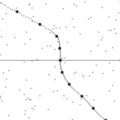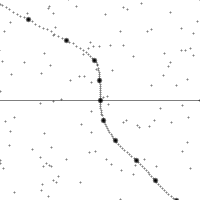File:Galilean transform of world line.gif
Galilean_transform_of_world_line.gif (200 × 200 pixels, file size: 134 KB, MIME type: image/gif, looped, 100 frames)
This file is from Wikimedia Commons and may be used by other projects. The description on its file description page there is shown below.
Summary
| DescriptionGalilean transform of world line.gif |
English: Changing views of spacetime along the world line of a slowly accelerating observer
In this animation, the vertical direction indicates time and the horizontal direction indicates distance, the dashed line is the spacetime trajectory ("world line") of the observer. The lower half of the diagram shows the events that are "earlier" than the observer, and the upper half shows events that are "later" than the observer. The small dots are arbitrary events in spacetime. The slope of the world line (deviation from being vertical) gives the relative velocity to the observer. Note how the view of spacetime changes when the observer accelerates. Compare Image:Lorentz transform of world line.gif, which depicts the situation for rapid acceleration according to special relativity. |
| Source | Own work |
| Author | Cyp |
| Other versions | |
| Source code InfoField | Source of program used to generate image:
//GPL
#include <stdio.h>
#include <stdlib.h>
#include <math.h>
#define PI 3.141592653589793238462
#define SX 200
#define SY 200
#define PL 100
#define DN 2000
unsigned char img[SX][SY];
double path[PL+1][2], dots[DN][2];
void dodot(int x, int y, double f) {
if(x<0||x>=SX||y<0||y>=SY) return;
img[y][x]*=f;
}
void dospot(int x, int y) {
dodot(x, y, .5);
dodot(x+1, y, .75);
dodot(x-1, y, .75);
dodot(x, y+1, .75);
dodot(x, y-1, .75);
}
void dobigspot(int x, int y) {
int a, b;
for(b=-3;b<=3;++b) for(a=-3;a<=3;++a) if(a*a+b*b<=9) dodot(x+a, y+b, (a*a+b*b)/10.);
}
void dospotd(double t, double x) {
dospot((x+1)*(SX/2.), (-t+1)*(SY/2.));
}
void dosmallspotd(double t, double x) {
dodot((x+1)*(SX/2.), (-t+1)*(SY/2.), .25);
}
void dobigspotd(double t, double x) {
dobigspot((x+1)*(SX/2.), (-t+1)*(SY/2.));
}
int main() {
char fn[100];
int n, x, y, t, i, w;
double a, b, da, db, ta, tb;
FILE *f;
path[0][0]=path[0][1]=0;
for(t=0;t<=PL;++t) path[t][1]=0;
for(n=1;n<10;++n) {
a=rand()%20000/10000.-1; a/=n*n*n*n/200.; b=rand()%20000*(PI/10000);
for(t=0;t<=PL;++t) {
path[t][1]+=a*sin((2*PI/PL)*n*t+b);
}
}
for(t=PL;t>=0;--t) path[t][1]-=path[0][1];
path[0][0]=0;
for(t=1;t<=PL;++t) {
a=path[t][1]-path[t-1][1];
path[t][0]=path[t-1][0]+ 1 /* sqrt(1+a*a) */ ;
}
for(t=0;t<DN;++t) {
a=rand()%20000/10000.-1; b=rand()%20000/10000.-1;
dots[t][0]=a*path[PL][0]/2; dots[t][1]=b*1000;
}
for(n=0;n<100;++n) {
i=PL*n/100;
a=path[i+1][0]-(da=path[i][0]); b=(db=path[i][1])-path[i+1][1]; /* a = 1, this is a galilean transform */
ta=path[PL][0]; tb=path[PL][1];
a/=50.; b/=50.;
for(y=0;y<SY;++y) for(x=0;x<SX;++x) img[y][x]=255;
/*for(y=0;y<SY;++y) img[y][y*SX/SY]*=.5;
for(y=0;y<SY;++y) img[y][(SY-y-1)*SX/SY]*=.5;*/
for(x=0;x<SX;++x) img[SY/2][x]*=.5;
for(w=-20;w<=20;++w)
for(t=0;t<PL;++t) dospotd(a*(path[t][0]-da-w*ta) /* +b*(path[t][1]-db-w*tb) */,
b*(path[t][0]-da-w*ta) +a*(path[t][1]-db-w*tb));
for(w=-20;w<=20;++w)
for(t=0;t<PL;t+=10) dobigspotd(a*(path[t][0]-da-w*ta) /* +b*(path[t][1]-db-w*tb) */,
b*(path[t][0]-da-w*ta) +a*(path[t][1]-db-w*tb));
for(w=-20;w<=20;++w)
for(t=0;t<DN;++t) dospotd(a*(dots[t][0]-da-w*ta) /* +b*(dots[t][1]-db-w*tb) */,
b*(dots[t][0]-da-w*ta) +a*(dots[t][1]-db-w*tb));
//if(n==0) printf("%lf; %lf, %lf, %lf; %lf, %lf, %lf, %lf, %lf\n", a*(path[PL][0]-da-1*ta)+b*(path[PL][1]-db-1*tb), path[PL][0], da, 1*ta, path[PL][1], db, 1*tb, path[0][0], path[0][1]);
sprintf(fn, "gal%04d.pgm", n);
f=fopen(fn, "wb");
fprintf(f, "P5\n%d %d\n255\n", SX, SY);
fwrite(img, 256*256, 1, f);
fclose(f);
}
return 0;
}
|
Licensing

|
Permission is granted to copy, distribute and/or modify this document under the terms of the GNU Free Documentation License, Version 1.2 or any later version published by the Free Software Foundation; with no Invariant Sections, no Front-Cover Texts, and no Back-Cover Texts. A copy of the license is included in the section entitled GNU Free Documentation License.http://www.gnu.org/copyleft/fdl.htmlGFDLGNU Free Documentation Licensetruetrue |
| This file is licensed under the Creative Commons Attribution-Share Alike 3.0 Unported license. | ||
| ||
| This licensing tag was added to this file as part of the GFDL licensing update.http://creativecommons.org/licenses/by-sa/3.0/CC BY-SA 3.0Creative Commons Attribution-Share Alike 3.0truetrue |
Captions
Items portrayed in this file
depicts
File history
Click on a date/time to view the file as it appeared at that time.
| Date/Time | Thumbnail | Dimensions | User | Comment | |
|---|---|---|---|---|---|
| current | 23:50, 9 November 2006 |  | 200 × 200 (134 KB) | wikimediacommons>Cyp | Source of program used to generate image: <pre>//GPL #include <stdio.h> #include <stdlib.h> #include <math.h> #define PI 3.141592653589793238462 #define SX 200 #define SY 200 #define PL 100 #define DN 2000 unsigned char img[SX][SY]; double path[PL+1][ |
File usage
There are no pages that use this file.
